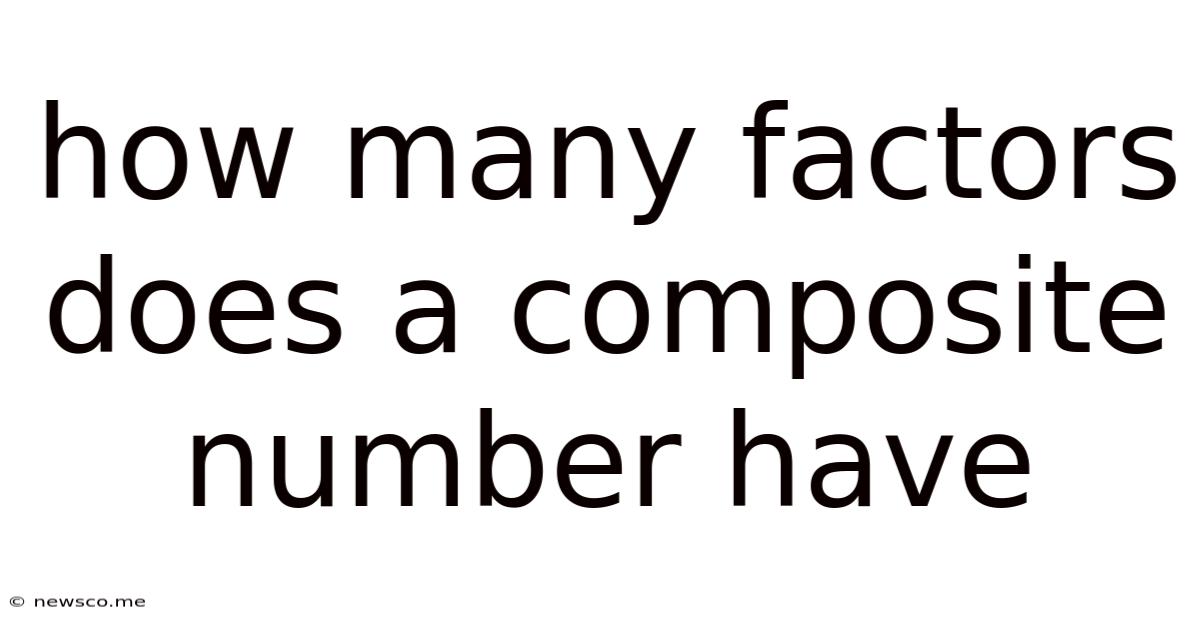How Many Factors Does A Composite Number Have
News Co
May 07, 2025 · 4 min read

Table of Contents
How Many Factors Does a Composite Number Have? Unlocking the Secrets of Divisibility
Understanding the number of factors a composite number possesses is fundamental to number theory and has wide-ranging applications in areas like cryptography and computer science. While seemingly simple, the concept unveils fascinating patterns and relationships within the number system. This comprehensive guide delves into the intricacies of factor counting, providing you with the tools and knowledge to confidently determine the number of factors for any composite number.
Understanding Prime Factorization: The Cornerstone of Factor Counting
Before we delve into the specifics of composite numbers, let's establish a crucial foundation: prime factorization. Every composite number can be uniquely expressed as a product of prime numbers. This prime factorization is the key to unlocking the number of factors a composite number has.
For example:
- 12 = 2 x 2 x 3 = 2² x 3¹
This means 12 is composed of the prime factors 2 and 3. Notice that we express the prime factorization using exponents to show the multiplicity of each prime factor. This representation is crucial in our upcoming calculations.
Why Prime Factorization Matters
The prime factorization of a number provides a systematic way to list all of its factors. Each factor is formed by combining the prime factors in various ways. The exponents in the prime factorization dictate how many choices we have for each prime factor when constructing a factor.
The Formula: Calculating the Number of Factors
The number of factors of a composite number can be efficiently calculated using a simple formula derived from its prime factorization. Let's consider a composite number n with its prime factorization:
n = p₁^a₁ x p₂^a₂ x ... x pₖ^aₖ
where:
- p₁, p₂, ..., pₖ are distinct prime numbers
- a₁, a₂, ..., aₖ are their respective exponents (positive integers)
The total number of factors (divisors) of n, denoted as τ(n) or d(n), is given by the formula:
τ(n) = (a₁ + 1)(a₂ + 1)...(aₖ + 1)
This formula elegantly connects the exponents in the prime factorization to the number of factors. Let's illustrate this with examples.
Examples: Putting the Formula into Practice
Example 1: Finding the Factors of 12
As we saw earlier, the prime factorization of 12 is 2² x 3¹. Using the formula:
τ(12) = (2 + 1)(1 + 1) = 3 x 2 = 6
Therefore, 12 has 6 factors: 1, 2, 3, 4, 6, and 12.
Example 2: A More Complex Case – Finding the Factors of 360
Let's analyze a larger number: 360. Its prime factorization is 2³ x 3² x 5¹.
Applying the formula:
τ(360) = (3 + 1)(2 + 1)(1 + 1) = 4 x 3 x 2 = 24
Thus, 360 has 24 factors.
Exploring Patterns and Special Cases
The formula reveals interesting patterns related to the number of factors:
-
Numbers with Many Factors: Numbers with multiple prime factors and high exponents tend to have a larger number of factors. This is directly reflected in the formula's multiplicative nature.
-
Perfect Squares: Perfect squares (numbers that are the square of an integer) always have an odd number of factors. This is because the exponents in their prime factorization are all even, and adding 1 to an even number always results in an odd number. The formula elegantly captures this property.
-
Perfect Cubes: Perfect cubes (numbers that are the cube of an integer) have a factor count influenced by the cube structure of their prime factor exponents.
-
Numbers with Only Two Factors: A number with only two factors is a prime number. The formula reflects this as its prime factorization consists of only one distinct prime raised to the power of 1, leading to (1+1) = 2 factors.
Advanced Applications and Extensions
The concept of factor counting extends beyond simply finding the number of divisors. It plays a crucial role in various mathematical fields and applications:
-
Cryptography: Understanding factor counts is important in devising and breaking encryption algorithms.
-
Number Theory: Factor counting contributes to deeper understanding of number properties, such as perfect numbers and highly composite numbers.
-
Computer Science: Efficient algorithms for prime factorization and factor counting are fundamental in computer science tasks.
Strategies for Efficient Factor Counting
While the formula provides a direct method, for very large composite numbers, directly computing the prime factorization can be computationally intensive. Here are some strategies for efficient factor counting:
-
Efficient Prime Factorization Algorithms: Algorithms like trial division, the Pollard rho algorithm, and the general number field sieve offer varying levels of efficiency in finding prime factors.
-
Approximation Methods: For extremely large numbers, approximation methods can estimate the number of factors without explicitly finding all of them.
Conclusion: Mastering the Art of Factor Counting
Understanding how to determine the number of factors a composite number has is a valuable skill with far-reaching applications. By mastering prime factorization and applying the formula derived from it, you can efficiently count the factors of any composite number. Remember that the seemingly simple act of counting factors reveals deeper insights into the structure and properties of numbers, impacting numerous mathematical and computational fields. The more you explore this area, the more fascinating and complex the world of numbers becomes. From understanding simple divisibility to tackling complex cryptographic problems, the ability to calculate the number of factors is an indispensable tool in your mathematical arsenal.
Latest Posts
Related Post
Thank you for visiting our website which covers about How Many Factors Does A Composite Number Have . We hope the information provided has been useful to you. Feel free to contact us if you have any questions or need further assistance. See you next time and don't miss to bookmark.